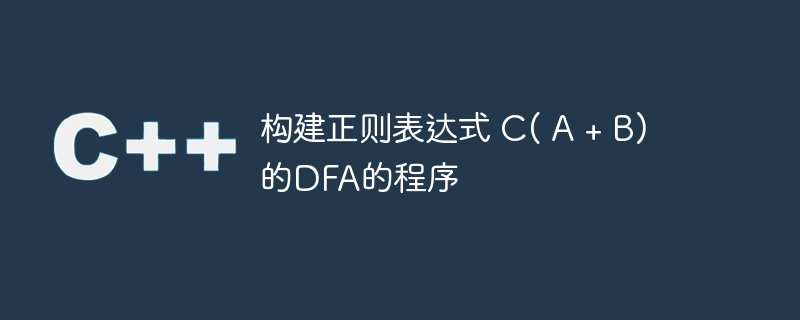Home >Backend Development >C++ >Program to construct a DFA of the regular expression C( A + B)
Program to construct a DFA of the regular expression C( A + B)
- WBOYWBOYWBOYWBOYWBOYWBOYWBOYWBOYWBOYWBOYWBOYWBOYWBforward
- 2023-08-26 11:09:071770browse

In this article, we will discuss how to construct a deterministic finite automaton (DFA) for the regular expression C(A B) using C. We'll start by understanding the problem and the theory behind it, then dive into implementation, and finally demonstrate its use with relevant examples.
Understanding the problem statement
A deterministic finite automaton (DFA) is a theoretical model of computation used in automata theory, a branch of theoretical computer science. It is one of the simplest types of automata and a fundamental concept in the study of compilers and parsers.
The task here is to write a DFA for the regular expression C(A B). This expression can be interpreted as "C" followed by one or more occurrences of "A" or "B". Our goal is to create a C program that checks if a given input string matches this regular expression.
Theoretical Background
A DFA consists of a set of states and transitions between these states on input symbols. It starts from the initial state and reads the input symbols. For each input symbol, it transitions to a new state until all input symbols have been read. A DFA accepts an input if and only if the input ends in a final (or accepted) state.
In this case, the DFA of the regular expression C(A B) can be visualized as follows -
Start status: q0
Accept status: q2
Conversion -
Enter q0 on "C" to go to q1
When entering "A" or "B", q1 goes to q2
Enter q2 on "A" or "B" to stay at q2
Example
Now let’s implement this DFA in C. Please note that this program only works with uppercase "A", "B" and "C".
#include <iostream>
#include <string>
using namespace std;
enum State { q0, q1, q2, q3 };
State getNextState(State currentState, char input) {
switch (currentState) {
case q0: return (input == 'C') ? q1 : q3;
case q1: return (input == 'A' || input == 'B') ? q2 : q3;
case q2: return (input == 'A' || input == 'B') ? q2 : q3;
default: return q3;
}
}
bool matchesRE(string s) {
State currentState = q0;
for (char c : s) {
currentState = getNextState(currentState, c);
}
return currentState == q2;
}
int main() {
string test = "CABAB";
cout << (matchesRE(test) ? "Matches Regular Expression" : "Does not match Regular Expression") << endl;
return 0;
}
Output
Matches Regular Expression
Test Case
We take the string "CABAB" as an example. The string starts with "C", followed by a series of "A" and "B". Therefore, it matches the regular expression C(A B) and the output of the program will be: "matches regular expression".
in conclusion
In this article, we take a closer look at the computationally theoretical model DFA and its application to validating regular expressions. We focus on the regular expression C(A B) and create a C program that checks whether an input string matches this regular expression. We hope this discussion was informative and helped you better understand DFA and its implementation in C.
The above is the detailed content of Program to construct a DFA of the regular expression C( A + B). For more information, please follow other related articles on the PHP Chinese website!
Related articles
See more- C++ compilation error: A header file is referenced multiple times, how to solve it?
- C++ compilation error: wrong function parameters, how to fix it?
- C++ error: The constructor must be declared in the public area, how to deal with it?
- Process management and thread synchronization in C++
- How to deal with data splitting problems in C++ development

